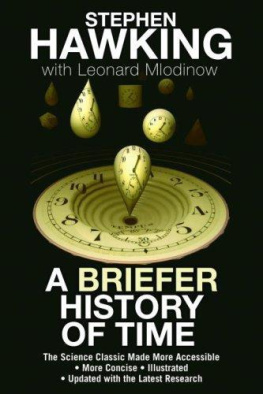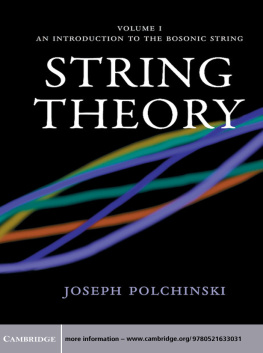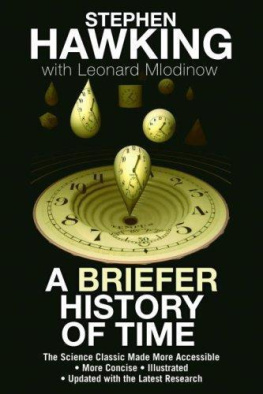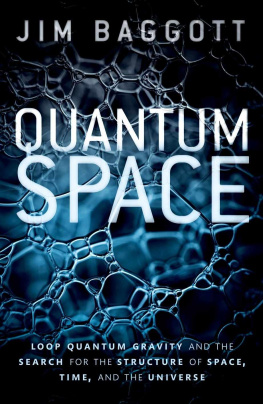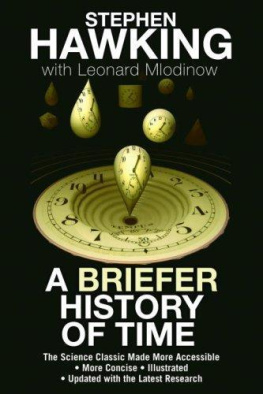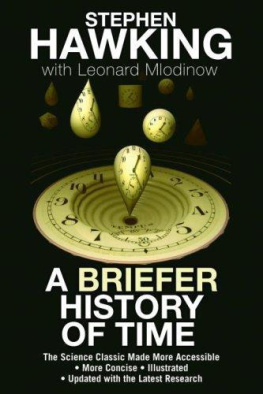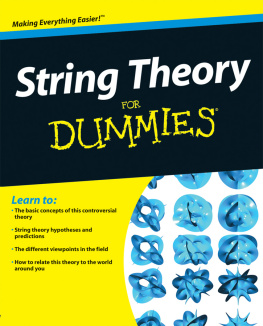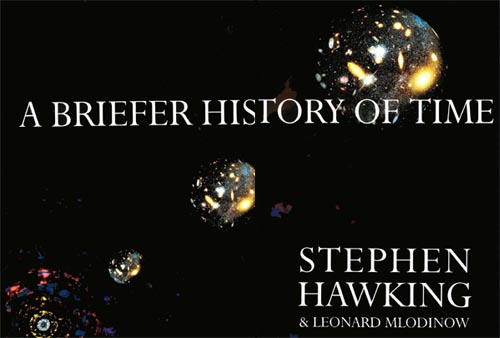
Table of Contents
Acknowledgments
Thanks to our editor, Ann Harris, at Bantam for lending us her considerable experience and talent in our efforts to hone the manuscript. To Glen Edelstein, Bantams art director, for his tireless efforts and his patience. To our art team, Philip Dunn, James Zhang, and Kees Veenenbos, for taking the time to learn some physics, and then, while not sacrificing the scientific content, making the book look fabulous. To our agents, Al Zuckerman and Susan Ginsburg at Writers House, for their intelligence, caring, and support. To Monica Guy for proof-reading. And to those who kindly read various drafts of the manuscript in our search for passages where clarity could be improved further: Donna Scott, Alexei Mlodinow, Nicolai Mlodinow, Mark Hillery, Joshua Webman, Stephen Youra, Robert Barkovitz, Martha Lowther, Katherine Ball, Amanda Bergen, Jeffrey Boehmer, Kimberly Comer, Peter Cook, Matthew Dickinson, Drew Donovanik, David Fralinger, Eleanor Grewal, Alicia Kingston, Victor Lamond, Michael Melton, Mychael Mulhern, Matthew Richards, Michelle Rose, Sarah Schmitt, Curtis Simmons, Christine Webb, and Christopher Wright.
Foreword
THE TITLE OF THIS BOOK DIFFERS by only two letters from that of a book first published in 1988. A Brief History of Time was on the London Sunday Times best-seller list for 237 weeks and has sold about one copy for every 750 men, women, and children on earth. It was a remarkable success for a book that addressed some of the most difficult issues in modern physics. Yet those difficult issues are also the most exciting, for they address big, basic questions: What do we really know about the universe? How do we know it? Where did the universe come from, and where is it going? Those questions were the essence of A Brief History of Time, and they are also the focus of this book.
In the years since A Brief History of Time was published, feedback has come in from readers of all ages, of all professions, and from all over the world. One repeated request has been for a new version, one that maintains the essence of A Brief History yet explains the most important concepts in a clearer, more leisurely manner. Although one might expect that such a book would be entitled A Less Brief History ofTime, it was also clear from the feedback that few readers are seeking a lengthy dissertation befitting a college-level course in cosmology. Thus, the present approach. In writing A Briefer History of Time we have maintained and expanded the essential content of the original book, yet taken care to maintain its length and readability. This is a briefer history indeed, for some of the more technical content has been left out, but we feel we have more than compensated for that by the more probing treatment of the material that is really the heart of the book.
We have also taken the opportunity to update the book and include new theoretical and observational results. A Briefer History of Time describes recent progress that has been made in finding a complete unified theory of all the forces of physics. In particular, it describes the progress made in string theory, and the "dualities" or correspondences between apparently different theories of physics that are an indication that there is a unified theory of physics. On the observational side, the book includes important new observations such as those made by the Cosmic Background Explorer satellite (COBE) and by the Hubble Space Telescope.
Some forty years ago Richard Feynman said, "We are lucky to live in an age in which we are still making discoveries. It is like the discovery of Americay ou only discover it once. The age in which we live is the age in which we are discovering the fundamental laws of nature." Today, we are closer than ever before to understanding the nature of the universe. Our goal in writing this book is to share some of the excitement of these discoveries, and the new picture of reality that is emerging as a result.
THINKING ABOUT THE UNIVERSE
WE LIVE IN A STRANGE AND wonderful universe. Its age, size, violence, and beauty require extraordinary imagination to appreciate. The place we humans hold within this vast cosmos can seem pretty insignificant. And so we try to make sense of it all and to see how we fit in. Some decades ago, a well-known scientist (some say it was Bertrand Russell) gave a public lecture on astronomy. He described how the earth orbits around the sun and how the sun, in turn, orbits around the center of a vast collection of stars called our galaxy. At the end of the lecture, a little old lady at the back of the room got up and said: "What you have told us is rubbish. The world is really a flat plate supported on the back of a giant turtle." The scientist gave a superior smile before replying, "What is the turtle standing on?" "Youre very clever, young man, very clever," said the old lady. "But its turtles all the way down!"
Most people nowadays would find the picture of our universe as an infinite tower of turtles rather ridiculous. But why should we think we know better? Forget for a minute what you knowor think you knowabout space. Then gaze upward at the night sky. What would you make of all those points of light? Are they tiny fires? It can be hard to imagine what they really are, for what they really are is far beyond our ordinary experience. If you are a regular stargazer, you have probably seen an elusive light hovering near the horizon at twilight. It is a planet, Mercury, but it is nothing like our own planet. A day on Mercury lasts for two-thirds of the planets year. Its surface reaches temperatures of over 400 degrees Celsius when the sun is out, then falls to almost 200 degrees Celsius in the dead of night. Yet as different as Mercury is from our own planet, it is not nearly as hard to imagine as a typical star, which is a huge furnace that burns billions of pounds of matter each second and reaches temperatures of tens of millions of degrees at its core.
Another thing that is hard to imagine is how far away the planets and stars really are. The ancient Chinese built stone towers so they could have a closer look at the stars. Its natural to think the stars and planets are much closer than they really areafter all, in everyday life we have no experience of the huge distances of space. Those distances are so large that it doesnt even make sense to measure them in feet or miles, the way we measure most lengths. Instead we use the light-year, which is the distance light travels in a year. In one second, a beam of light will travel 186,000 miles, so a light-year is a very long distance. The nearest star, other than our sun, is called Proxima Centauri (also known as Alpha Centauri C), which is about four light-years away. That is so far that even with the fastest spaceship on the drawing boards today, a trip to it would take about ten thousand years.
Ancient people tried hard to understand the universe, but they hadnt yet developed our mathematics and science. Today we have powerful tools: mental tools such as mathematics and the scientific method, and technological tools like computers and telescopes. With the help of these tools, scientists have pieced together a lot of knowledge about space. But what do we really know about the universe, and how do we know it? Where did the universe come from? Where is it going? Did the universe have a beginning, and if so, what happened before then? What is the nature of time? Will it ever come to an end? Can we go backward in time? Recent breakthroughs in physics, made possible in part by new technology, suggest answers to some of these long-standing questions. Someday these answers may seem as obvious to us as the earth orbiting the sunor perhaps as ridiculous as a tower of turtles. Only time (whatever that may be) will tell.
Next page
